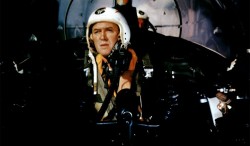Cinema | November 9th, 2016

This Friday, November 11, is Veterans Day, once called Armistice Day, to mark the ceasefire that ended World War I hostilities on that date in 1918. It’s one of the very few national holidays that does not move to the nearest Monday (although it did for several years in the 1970s). The date still calls to mind “the war to end all wars,” but after World War II and the Korean War the name was changed to Veterans Day. Since 1954 it officially honors military veterans in general, not just those of the First World War, “for their patriotism, love of country, and willingness to serve and sacrifice for the common good,” as noted by the U.S. Office of Veterans Affairs in their history of the holiday.
Numerous movies memorialize the actions and courage of soldiers in wartime, as well as their struggles to readjust to civilian life after service, but relatively few films celebrate their activities between major wars. One of those is Anthony Mann’s “Strategic Air Command,” which was filmed by Paramount Pictures in 1954 and released theatrically in 1955 during the height of the Cold War.
Perhaps not coincidentally, the Grand Forks Air Force Base was constructed the following year, opening in 1957, and becoming a Strategic Air Command base from 1958 until reassigned when SAC was deactivated in 1992.
Last month Olive Films came out with a sparkling new Blu-ray of Mann’s film, a production that has its dramatic ups and downs but perfectly embodies the V.A. Office description of the purpose of Veterans Day.
“Strategic Air Command” stars James Stewart as a former World War II bomber pilot named Robert “Dutch” Holland, who in 1951, as the story begins, is a major league baseball player on inactive duty in the Air Force Reserve. Stewart himself had been a WWII pilot and actually was an Air Force Reserve colonel when the film was shot, so was able to influence the film’s production.
The film begins as an idealized portrait of postwar family life, with Dutch Holland in young middle-age but still at the height of his baseball career, recently-married for the first time, and just moved into a new house. The first major conflict quickly arises during his baseball spring training when the Air Force calls him back to 21 months of active duty. Holland is naturally upset at the sudden change in his plans and is extremely reluctant to return to the service, but his new wife Sally (June Allyson) puts on a strong face and show of support despite her disappointment at the little time she is able to see him due to his frequent flying missions.
Holland gradually settles into his position and becomes more enthusiastic when allowed to go back to flying rather than sitting behind a desk. It is at about this point that the film shifts gears into a long but slick, idealized docudrama advertisement for the Air Force, alternating with an often-tedious marital melodrama about the many family sacrifices necessary for military personnel.
On the other hand, there are very effective and dramatic sequences showing a couple of Holland’s important missions. The strongest is a harrowing test flight in arctic weather when an engine catches fire over Greenland. Another is the pioneering nonstop flight from Florida to Japan with a mid-flight refueling near Alaska. As Leonard Maltin’s “Movie Guide” rather simplistically puts it, the film “only gets off the ground when Stewart does.”
Stewart’s performance pretty much carries the film, with decent support from Harry Morgan, Frank Lovejoy, and Jay C. Flippen, among others. There’s also a nice music score by Victor Young to reinforce the screen action. The film will obviously have the greatest appeal to Air Force veterans and their families, but is a few steps above a routine military propaganda film (even for the troubled mid-1950s). Tepid drama aside, it’s a valuable slice of national attitude for social historians of the Cold War era.
What really makes “Strategic Air Command” worth watching, over and above its patriotic themes for Veterans Day, is the incredible clarity of its wide-format VistaVision image, which has a sharpness and vividness of color that makes it look like it was filmed yesterday. (The catchline for the process was “Motion Picture High Fidelity” as the photographed image area was double the size of what standard 35mm movie film used.)
Extensive and spectacular aerial cinematography lovingly captures the now-rare aircraft in flight (mostly B-36 and B-47 bombers), a treat for any aviation buff. Classic car enthusiasts likewise will appreciate the pristine look of mid-20th century autos and history buffs of the era in general can luxuriate in all the details of daily life as though looking through a window into the past.
Olive’s HD transfer is at the 1.66:1 aspect ratio and will look its best projected onto a large screen. During this transitional period of widescreen moviemaking, the picture was composed to be compatible with 1.66, 1.85, and 2:1 screens, but probably looks most natural at 1.66.
Audio is quite good, but unfortunately the disc’s DTS-HD MA lossless soundtrack does not recreate the “fake stereo” 3-channel Perspecta Sound process, which electronically shifted the mono recording to the left, center, and/or right speakers at key moments. Sadly the disc’s only bonus features are main and chapter menus plus optional English subtitles.
STRATEGIC AIR COMMAND on Blu-ray -- Movie: B- / Video: A+ / Audio: A- / Extras: F
December 29th 2025
December 29th 2025
December 16th 2025
December 9th 2025
December 2nd 2025

__293px-wide.jpg)
__293px-wide.jpg)

_(1)_(1)_(1)__293px-wide.jpg)
_(1)__293px-wide.jpg)